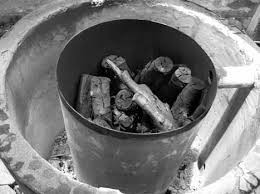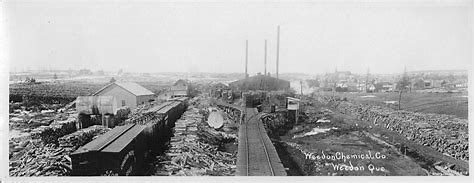The great Mt. Kearsarge Pyroligneous Acid Factory Mystery
By Sooze Hodgson and Anne Hewitt
In mid-October 2020, while out on SRK Trail 10, we decided to detour south towards West Salisbury on the Kearsarge Mt. Rd. (also known as the Old Lead Mine Road). After about three miles we came upon this huge stone wall structure in the woods on the west side of Old Lead Mine Rd., in the middle of nowhere. We explored the site enough to determine that this huge stone structure was no old farm structure. On our hike back out, we encountered a local resident and asked him if he knew anything about the ruin. “Some locals say that was the old acid factory,” he replied.
Back at home we did some research and learned this was the Kearsarge Coal and Pyroligneous Acid factory, used in the mid-nineteenth century to produce charcoal and wood acid and other solvents distilled from the charcoaling process.
Andover’s Charcoal and Pyroligneous Acid Factory

Charcoal kiln found in a Pyroligneous acid factory
Long before our society ran on petroleum it ran on wood (1). For thousands of years humans have used wood for shelter, heating, and cooking, and have also derived many useful byproducts from wood. Before the colonization of the New World, European foresters had perfected the skill of making charcoal from wood. By heating hardwoods in a closed environment with little oxygen, the wood was turned into charcoal, a valuable commodity that burns with an intense and steady heat. Charcoal fires enabled craftsmen to refine metal ores and were valuable in blacksmithing and other manufacturing.
Early charcoal manufacturers also learned how to distill many products from the smoke and fumes emitted by charcoal ovens. Indeed, many of these distillation products became more valuable than the charcoal itself. Pyroligneous acid, also called “wood vinegar” (because it was largely acetic acid, the primary component of vinegar), was one of the many valuable distillation products recovered from charcoal kilns (2). Pyroligneous acid had a variety of uses: in cloth-making, it could fix the dyes in calico fabrics; in blasting, it was used in the production of cordite (as a substitute for black powder); and in agriculture, it could serve as a pesticide or herbicide. The processing of charcoal led to many other byproducts in addition to pyroligneous acid. Acetone, methanol, and aldehydes also were distilled from the vapors from the manufacturing of charcoal and were sold as valuable solvents (3). Curious mechanics, farmers, homemakers, and inventors were continually testing other possible applications for the byproducts from the charcoal and wood-acid industry.
By the early 1800s a robust wood-acid industry had developed in the United States (1). The first wood-acid factory in the country was built in Northampton, MA in 1830. Others were soon built in New Hampshire, Massachusetts, Vermont, and upstate New York (1). These factories were typically located where there was a ready source both of hardwood trees, principally beech, birch (5), and oak (6), and of water or snow. The water was used for cooling and condensing distillation products from cast-iron or copper “retorts” situated directly above the charcoal kilns. Vapors from the retorts were channeled through long cast-iron pipes which might be 100’ in length (2), and the condensed distillation products were decanted off.

Note the acreage used for seasoned wood
In January 1856 a correspondent from the Vermont Phoenix newspaper wrote about his trip to Potter Place to visit the Kearsarge Mountain Coal and Pyroligneous Acid Factory (2). At that time the factory had four large cast-iron retorts, cylindrical in shape and about eight feet in diameter. Each tightly closed retort held a cord of hardwood. The bases of the retorts were connected by a one-foot diameter tube through which heat was applied to the retorts for about 12 hours, converting the wood to high grade charcoal. A long cast-iron tube connecting all the retorts collected the gasses and steam that escaped from the wood during the “coaling” process. The vapors in this long tube were condensed by means of water, snow, or ice. The liquid pyroligneous acid was decanted off from the thicker tars and was barreled for market. The coaling process yielded about 40-60 bushels of charcoal per cord of wood, a “coal . . . of the purest quality . . . much esteemed for use in the manufacture of edge tools.” (2). Each cord of wood also produced about 20 gallons of pyroligneous acid, which the correspondent noted was selling for $0.17/gallon. At the time of his visit he noted, “The proprietors will soon extend their works so as to keep 12 retorts, and the other connecting apparatus in constant action. The business is comparatively in its infancy, but bids fair to become important and highly remunerative.” (2). The factory could market its products via the new (1847) Northern Railroad; the Potter Place junction was only some six miles away via a rugged downhill road.
To judge by the present ruins, the Kearsarge Mountain Pyroligneous Acid factory probably never expanded as the proprietors had hoped in 1856. Nor is it known how long the factory remained active. In 1858 the Acid Factory on the Old Lead Mine Road is still noted and identified on the Andover Town Map. By 1898 no buildings of any kind are noted on the Andover Town Map in this area, nor is the business mentioned in Eastman’s History of the Town of Andover (4, E. Hiller).
What led to the decline and disappearance of pyroligneous acid factories? One can surmise different reasons for the disappearance of this wood industry. The factories led to large areas of deforestation, which would require relocation of factories and all their heavy equipment, and/or expensive hauling of tons of hardwood to the factories. In the nineteenth century there was no plan for timber management and reforestation. Many deforested areas with poor soil simply never regrew trees. Wood-acid factories led to pollution of streams and other local water systems. Then arose the Age of Fossil Fuels and Petroleum. Between 1836 and 1840 scientists had discovered that distillates from petroleum could be used for illumination. In 1859 Edwin Drake drilled the first successful oil well in Titusville, PA., and the rest is history – we had moved on from the Age of Wood to the Age of Fossil Fuels and Petroleum.
Sources:
- Canham, Hugh O. “The Wood Chemical Industry in the Northeast: An Old Industry with New Possibilities.” Northern Woodlands Magazine – Winter 2009. 2/8/2010.
- “Kearsarge Mountain – Manufacture of Coal and Pyroligneous Acid.” The Vermont Phoenix. Brattleboro, Vt. 2/2/1856.
- “Pyroligneous Acid or Wood Vinegar.” Scientific American 13 (10). 11/14/1857.
- Personal communications with Mr. Ed Hiller and Mr. John Hodgson, Andover Historical Society, Andover, NH.
- “How Pyroligneous Acid is Made.” Courier-Journal, Louisville, KY. 09/06/1875.
- The Household Cyclopedia. Note by Henry Hartshorne. 1881. Courtesy of Ed Hiller.
- With special thanks to John Hodgson and Midge Eliassen
Photo credits:- www.google.com/search?q=charcoal+retort+kiln+1856&rlz=1C1FGUR_enUS754US754&oq=charcoal+retort+kiln+1856&aqs=chrome..69i57j0i333l4.1386
- www.bing.com/images/search?q=pictures+of+pyroligneous+acid+factories&qpvt=pictures+of+pyroligneous+acid+factories&form=IQFRML&first=1&tsc=ImageBasicHover
